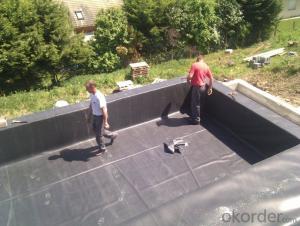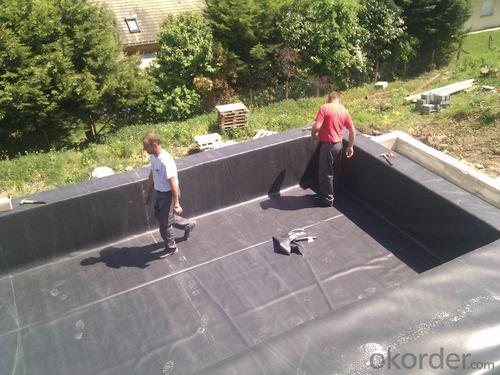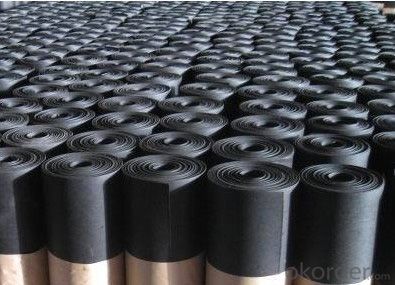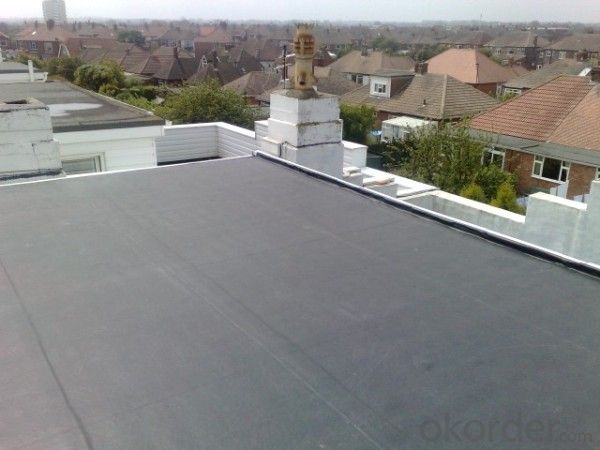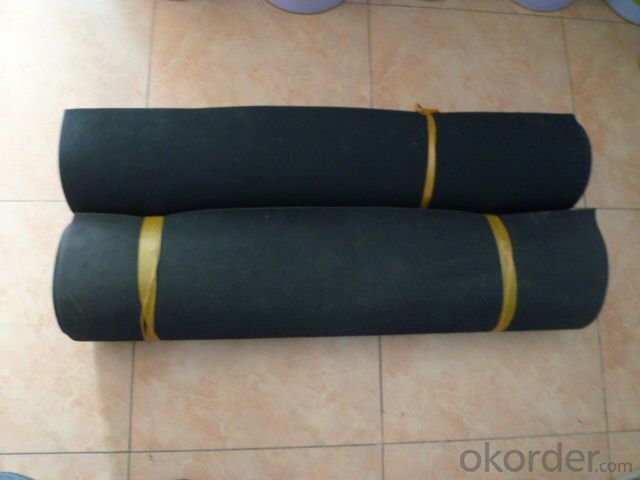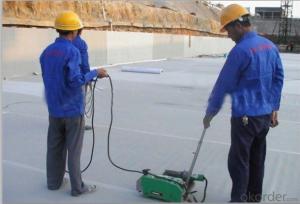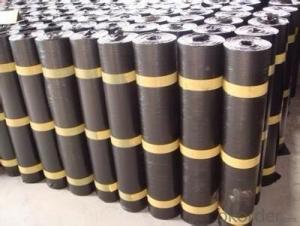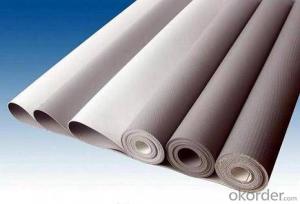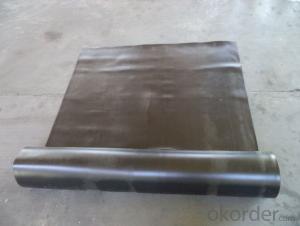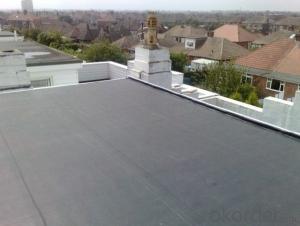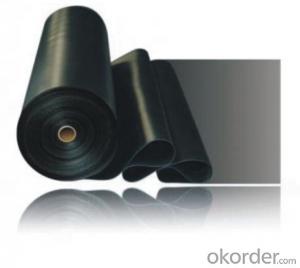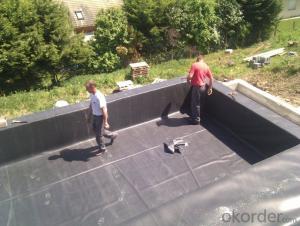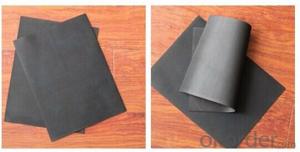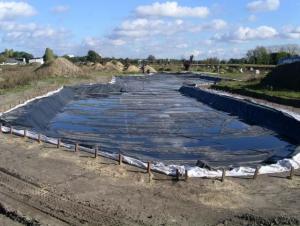EPDM Waterproof Membrane with Weldable for Pond Liner
- Loading Port:
- Shanghai
- Payment Terms:
- TT OR LC
- Min Order Qty:
- 50000 m²
- Supply Capability:
- 5000000 m²/month
OKorder Service Pledge
OKorder Financial Service
You Might Also Like
EPDM Waterproof Membrane with Weldable for Pond Liner
Description Of EPDM Waterproof Membrane with Weldable for Pond Liner:
1. Excellent physical and mechanical performance, high tearing resistance;good deformation adaptability, high puncture resistance;
2. High aging resistance, high UV resistance, anti-acid & alkali;
3. Excellent low & high temperature resistance, innocuous, long life span;
4. Perfect water proof performance, seepage and humidity resistance.
Main Features of EPDM Waterproof Membrane with Weldable for Pond Liner:
A.Polyester based SBS Modified Bitumen Waterproofing Membrane
a. Strong impermeability
b. High tensile strength, elongation, ability to adapt the grassroots shrinkage deformation and cracking
c. Puncture-resistant, broken resistant, tear-resistant
d. The corrosion resistance, resistance to mildew, weathering good
e. Construction convenient, hot-melt can be operated Four Seasons Construction, reliable joints
B. Fiberglass based SBS Modified Bitumen Waterproofing Membrane
a. High tensile strength, stability of a good size
b. High Temperature good performance
c. Damage resistance, corrosion resistance, resistance to mildew, weathering good performance
d. Good construction performance, reliable joints.
Specifications of EPDM Waterproof Membrane with Weldable for Pond Liner:
| Material | EPDM Rubber |
| Size | 1.2m (width)*20m (length) or customized, weldable type 2.05m or 4m width |
| Thick | 1.2mm, 1.5mm, 2.0mm |
| Type | Vulcanized & Weldable |
| Pattern | Non-reinforced (homogeneous) |
| Certificate | ISO9001/14001 |
Applications of EPDM Waterproof Membrane with Weldable for Pond Liner:
geomembrane used in groundsill of road, highway, railway and waterproof layer of swelling clay and wet collapsed loess.Geomembrane can be widely used in areas of garbage burying, waste disposal and underground construction projects.such as below:
- aquaculture ponds
- Ouchi root barrier membrane
- Floating baffles;
- Process wastewater
- Stormwater impoundments;
- Secondary containment;
- Spill containment
- Manure and biogas tanks and covers
- Potable water tanks and covers;
- Sludge Drying beds;
- Bioremediation covers & liners;
- Leachate ponds



IMages of EPDM Waterproof Membrane with Weldable for Pond Liner:




FAQ of EPDM Waterproof Membrane with Weldable for Pond Liner:
1. What are we supplying?
We are specialized in producing Colorful Asphalt Roof Shingle, SBS/APP modified bitumen waterproof membrane, Self adhesive bitumen waterproof membrane, PVC waterproofing membrane, EPDM rubber roofing membrane, Single Component Polyurethane Waterproof Coating, and Spray Polyurea Waterproof Coating
.
2. How Many years experience do we have?
We have been exported to more than 20 countries in the past 15 years.
3. How long do we usually reply your request?
We always reply our customer within 24 hours.
- Q: Is a waterproofing membrane resistant to algae or moss growth?
- A waterproofing membrane is usually resistant to the growth of algae or moss. Its purpose is to form a barrier against water infiltration, preventing moisture from seeping into the underlying structure. These membranes are typically composed of materials that are not favorable for the growth of algae or moss, such as synthetic polymers or rubberized compounds. Furthermore, they are often treated with additives that hinder the growth of organic matter, including algae or moss. Nevertheless, it is crucial to acknowledge that if the membrane is consistently exposed to moisture or damp conditions over time, it may become a breeding ground for algae or moss. Therefore, it is important to regularly maintain and clean the waterproofing membrane to ensure its longevity and effectiveness.
- Q: Can a waterproofing membrane prevent water leakage in basements?
- Yes, a waterproofing membrane can effectively prevent water leakage in basements. The membrane acts as a barrier, preventing water from seeping through the foundation walls or basement floors. It is designed to withstand hydrostatic pressure and provide a durable and long-lasting solution to keep basements dry and protected from water damage.
- Q: Can a waterproofing membrane be used for elevator shafts and stairwells?
- Yes, a waterproofing membrane can be used for elevator shafts and stairwells. Elevator shafts and stairwells are areas that are prone to moisture and water infiltration, especially in below-grade or high-moisture environments. Waterproofing membranes are designed to provide a barrier against water penetration and protect the structure from potential damage caused by moisture. When applied correctly, a waterproofing membrane can effectively prevent water from seeping into elevator shafts and stairwells, keeping them dry and free from water-related issues such as mold growth, deterioration of materials, and structural damage. These membranes are typically made from durable materials such as modified bitumen, PVC, or rubberized asphalt, which offer excellent waterproofing properties. It is important to choose a waterproofing membrane that is specifically designed for below-grade or high-moisture applications. These membranes should have high resistance to hydrostatic pressure, be capable of bridging cracks, and have long-term durability to withstand the constant exposure to moisture. Additionally, the installation of a waterproofing membrane in elevator shafts and stairwells should be done by trained professionals who have experience in waterproofing systems. This will ensure that the membrane is installed correctly, providing an effective barrier against water infiltration. In summary, a waterproofing membrane is a suitable solution for elevator shafts and stairwells as it can effectively prevent water penetration and protect the structure from moisture-related issues.
- Q: Can a waterproofing membrane be used for water treatment plants?
- Yes, a waterproofing membrane can be used for water treatment plants. Waterproofing membranes are designed to prevent the passage of water and can be used to provide a barrier against water leakage in various structures, including water treatment plants. These membranes can be applied to different areas of the plant, such as tanks, reservoirs, pipes, and basements, to prevent water infiltration and protect the infrastructure from potential damage. Additionally, waterproofing membranes can help maintain the integrity of the water treatment process by ensuring that water remains contained within designated areas and does not seep into surrounding soil or structures.
- Q: Does a waterproofing membrane have any impact on the thermal performance of a structure?
- Yes, a waterproofing membrane can have an impact on the thermal performance of a structure. A waterproofing membrane is typically used in buildings to prevent water infiltration, which can cause damage to the structure over time. By creating a barrier against moisture, the membrane helps to maintain the integrity of the building envelope and protect against potential leaks or water damage. In terms of thermal performance, a waterproofing membrane can help to improve insulation by reducing the amount of heat transfer through the building envelope. By preventing moisture from entering the structure, the membrane also helps to prevent the formation of condensation, which can lead to mold growth and further damage to the building materials. Furthermore, some waterproofing membranes are designed with additional insulation properties, such as foam or reflective coatings, which can further enhance the thermal performance of a structure. These membranes help to reduce thermal bridging and improve energy efficiency by minimizing heat loss or gain through the building envelope. It is important to note that the impact of a waterproofing membrane on the thermal performance of a structure can vary depending on the specific type of membrane, its installation, and the overall design of the building. It is advisable to consult with a professional architect or engineer to determine the most suitable waterproofing solution that meets both the water resistance and thermal performance requirements for a particular structure.
- Q: What is the difference between construction non-vulcanized waterproofing membrane and vulcanized waterproofing membrane?
- Non-vulcanized rubber waterproofing membrane: from SR or SR and asphalt blends by mixing, rolling made of coil, without vulcanization can use the product. The bonding between the coils and their bonding properties with the mortar is good, the manufacturing is convenient, the price is low, but the tensile strength is low. Can be divided into two types of rubber and rubber asphalt. Rubber type commonly used SBR and other SR production. Generally used for civil construction roof waterproof.
- Q: Can a waterproofing membrane be used on drywall surfaces?
- Yes, a waterproofing membrane can be used on drywall surfaces. Drywall is a porous material that can be susceptible to moisture damage, especially in areas prone to high humidity or water exposure, such as bathrooms or basements. Applying a waterproofing membrane on drywall helps create a barrier against moisture, preventing water infiltration and potential damage. This membrane can be in the form of a liquid coating or a sheet membrane that is applied directly onto the drywall surface. It is important to follow the manufacturer's instructions and ensure proper installation to achieve effective waterproofing and protect the drywall from moisture-related issues like mold, mildew, and rot.
- Q: How much does a waterproofing membrane cost?
- The cost of a waterproofing membrane can vary depending on several factors. The type of membrane, the size of the area to be waterproofed, and the complexity of the installation can all affect the price. On average, the cost of a waterproofing membrane can range from $1 to $5 per square foot. However, this is just a rough estimate and the actual cost can be higher or lower based on the aforementioned factors. For example, a basic sheet membrane made of PVC or EPDM might be on the lower end of the price range, while a liquid-applied membrane or a more advanced system like a bentonite clay membrane can be on the higher end. Additionally, the size of the area to be waterproofed will impact the cost. Larger areas will require more materials, labor, and time, which can increase the overall price. Complexity of the installation is another factor to consider. If the area is hard to access or requires extensive preparation work, such as removing existing materials or repairing cracks, the cost may be higher. It is recommended to consult with a professional waterproofing contractor who can assess your specific needs, provide an accurate estimate, and recommend the most suitable waterproofing membrane for your project.
- Q: Can a waterproofing membrane be used on storage tanks?
- Indeed, storage tanks can benefit from the application of a waterproofing membrane. These specialized membranes serve as a barrier, preventing the infiltration of water or other liquids into the surface they are applied to. By employing such membranes, storage tanks are shielded from the detrimental effects of leaks, corrosion, and moisture-related damage. Numerous industries, including oil and gas, chemical, and water treatment, rely on waterproofing membranes to uphold the durability and longevity of their storage tanks. Furthermore, these membranes can be customized to meet specific requirements, such as resistance to chemicals, UV exposure, or high temperatures, thus making them well-suited for a diverse array of storage tank applications.
- Q: Can waterproofing membranes be used on terraces?
- Yes, waterproofing membranes can definitely be used on terraces. In fact, using waterproofing membranes on terraces is highly recommended to protect the structural integrity of the terrace and prevent water damage. Waterproofing membranes act as a barrier, preventing water from seeping into the terrace and causing leaks or cracks. They are commonly used on flat terraces, rooftop terraces, and balconies to ensure that water does not penetrate the surface and cause damage to the underlying structure. Waterproofing membranes are available in various types, such as liquid-applied membranes, sheet membranes, and self-adhesive membranes, providing different options to suit the specific needs and requirements of the terrace. By applying a waterproofing membrane, the terrace can be protected from moisture, UV rays, and other environmental factors, extending its lifespan and ensuring a durable and long-lasting surface.
Send your message to us
EPDM Waterproof Membrane with Weldable for Pond Liner
- Loading Port:
- Shanghai
- Payment Terms:
- TT OR LC
- Min Order Qty:
- 50000 m²
- Supply Capability:
- 5000000 m²/month
OKorder Service Pledge
OKorder Financial Service
Similar products
Hot products
Hot Searches
Related keywords
